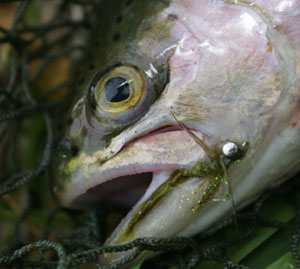A relative of the dragonflies (order Odonata), the damselfly is a favourite summer food item of the stillwater trout. While trout will, at times, take the unmistakable, vivid-blue adult insect, it’s the nymph form of the damselfly that is of most interest to them… and, therefore, us, the anglers.
The life cycle begins when, after mating, the female insect lays eggs on a stone or piece of vegetation under the water, which soon hatch to become tiny damselfly larvae. Each nymph may live up to five years in the water before it becomes an adult. During this time it will feed on smaller insects and decaying matter, shedding its hard skin as it increases in size.
The nymph swims by using a slow, but graceful, movement, by flexing its long, slim body from side to side, mainly living and hunting around weeded areas.
When it’s time for the insect to hatch it will crawl from the water – usually on a sunny day – onto a weed stem or suchlike. Here the insect sheds its final skin to reveal the adult underneath. Several days prior to this happening the nymph will become more active, having to swim to the surface to breath air. It’s at this point that it is particularly susceptible to the marauding trout.
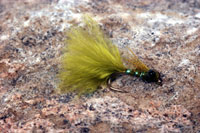 |
Golden Olive Living Damsel
Hook: Standard-shank, size 12
Eyes: Black dumbbell eyes
Tail: Golden olive marabou, plaited
Thorax: Golden olive seal’s fur
Rib: Oval gold tinsel
Thorax cover: Pheasant tail fibres
Legs: Golden olive partridge
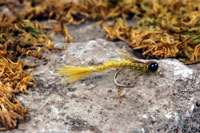 |
Skinny Damsel
Hook: Standard-shank, size 12
Eyes: Black dumbbell eyes
Tail: Olive marabou
Body: Fine olive dubbing
Rib: Flat pearl tinsel
Thorax: Fine olive dubbing
Thorax cover: Pheasant tail fibres
Legs: Golden olive partridge
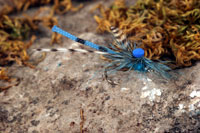 |
Braided Butt Damsel
Hook: Straight-eye, curved hook, size 10
Tail: Braided monofilament, coloured blue and black
Wings: Grizzle hackle tips
Thorax: Blue dubbing
Wing post: Blue Ethafoam
Hackle: Blue grizzle cock
RODS
To extract the most out of fishing damsel patterns you’d be best to go with a proper rod, say a 10ft 7-wt – something with a little bit of poke. The more distance you achieve, the longer the fly is in the water. This means that a lot more fish should, realistically, see it.
For distance work, a fast-actioned rod is the ideal tool for the job. Not only can you achieve casts to the horizon, but it’ll also help you hook fish at range much more effectively than a soft rod.
Don’t get too hung up about reaching the horizon, though, because quite often fish can be picked up in and around the margins.
LINES
All manner of lines work for fishing damsels, so make sure you carry everything from a floater to a fast-sinking line.
The best line, however, will probably be either the midge-tip or intermediate line. The reason for these lines being so effective, more so than the others, is the fact that they allow you to retrieve the fly on a level plain, just like the real thing.
If you can keep the pattern at a certain level and bring the fly all the way back to the rod tip this way, then you stand more chance of catching a fish properly that is feeding on damsel nymphs.
LEADERS AND TIPPETS
If you intend to go at the water with a single fly, then you won’t go far wrong with a tapered leader of some description or another. These can make all the difference, especially when you’re trying to achieve that little bit more distance. It means that the fly is going to turn over and, effectively, be fishing as soon as it enters the water.
When you are trying to cast far, with a single length of straight-through leader, the fly can sometimes land near the fly line. If this happens then the fly can be taken on the drop without any takes being registered – you don’t want this.
Tippets don’t need to be fragile, web-like affairs for this kind of fishing. Something like 6lb breaking strain is ideal; you could even up that to 8lb if there are big fish about.
To get the most from this kind of fishing it can pay dividends to fish a couple of flies. Go for a weighted or gold head fly on the point and an unweighted pattern on a dropper, say, five feet above the point fly. You’ll cover more water, and at the same time get an idea of the depth the fish are feeding at.
RETRIEVES
If you are able to see a damsel nymph underwater you’ll see that they’re very mobile characters. They are aggressive predators and very capable swimmers, swimming from one place to another before resting.
One of the best retrieves is the good old figure-of eight, but not to fast, just slow and steady to mimic the natural insect.
Another very special retrieve is to execute a 1ft pull, at the same time vibrating the rod tip up and down with your casting hand.
The whole idea is to try to achieve the same undulating movement as the natural insect; this is why long-tailed patterns can be so effective.
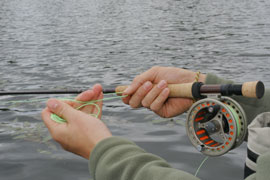 |
| Try using a jerky figure-of-eight retrieve… |
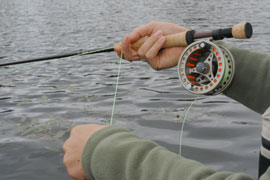 |
| … interspersed with a few 1ft pulls. |
LOCATION
Damsels can be found in most still waters and slow-moving waterways, so there is sure to be some in your nearest lake or reservoir.
Weed beds are the number-one locations for damsel nymphs, especially long-stemmed weeds, because the nymphs wait on the underside of leaves to ambush their prey.
Damsels have to crawl out of the water to emerge, so any kind of structure should be paid close attention to. Weed beds, fence posts, trees and boat docks should all be concentrated on. It is from these structures, free from the water, that the nymphs change into adult insects.
Before this change occurs, however, the more clued-up trout can be seen swimming up against these reed beds, knocking the half-emerged damsels back into the water where they are easy pickings.
ADULT DAMSELS
Quite often, although some people will tell you otherwise, trout can really switch on to adult damselflies. If conditions are right, then the trout will actively feed on the egg-laying females.
Dry a suitable imitation – there are plenty out there. Fishing the fly dead drift is often a good tactic. You can also make the fly seem like a struggling insect by giving a quick twitch to your line every now and then.
Make sure you use stout leader again, as these big flies tend to spin when casting. And, remember, you’ll often be fishing near weed beds, so don’t go too light-handed.


